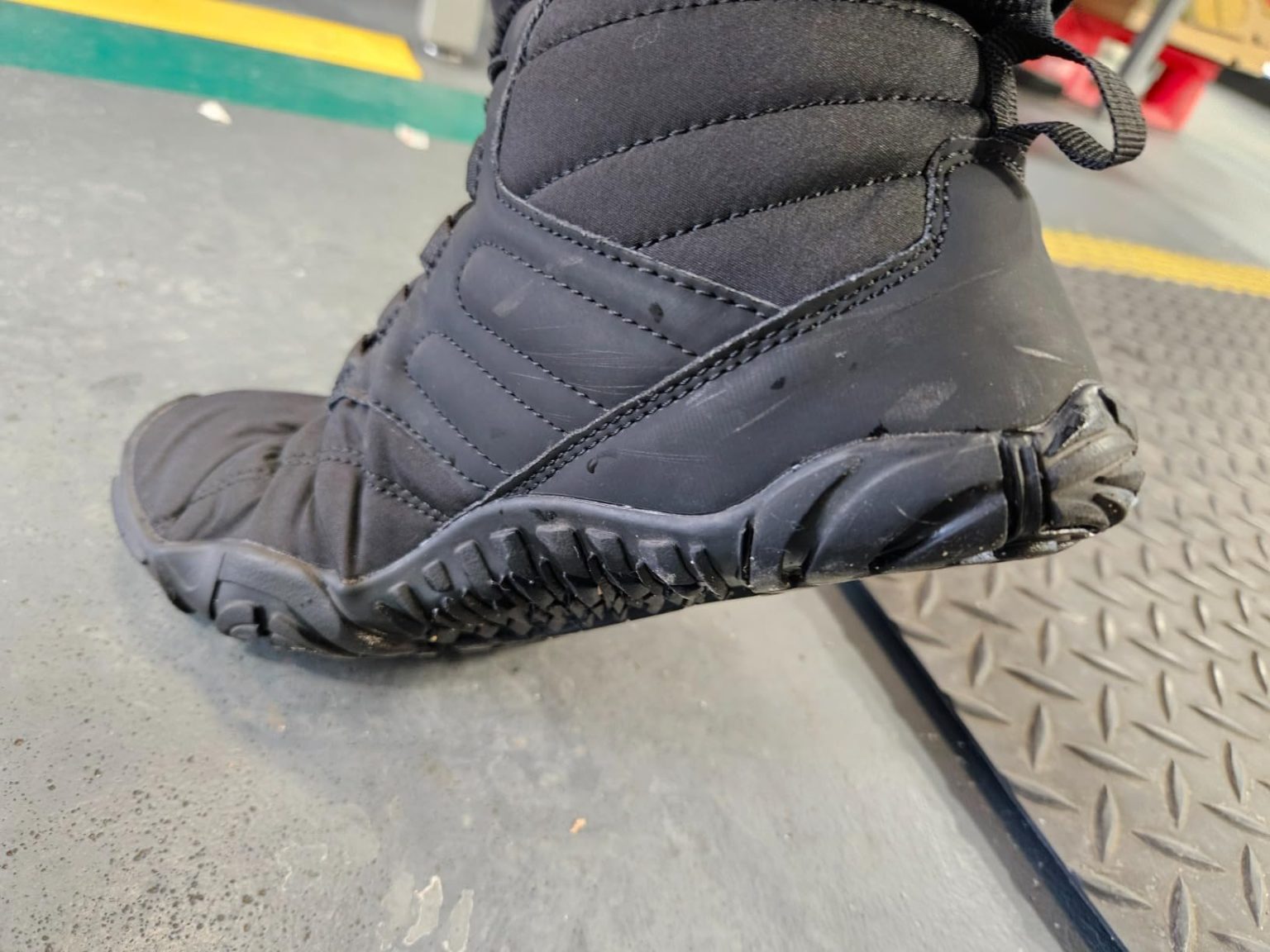Last month, I was skeptical when my neighbor recommended these budget Winter Hike Barefoot Boots. “For twenty bucks, they’re actually decent,” she said. Mike here, and after testing footwear for over a decade, I’ve learned that cheap usually means disappointment. But after 6 weeks of putting these boots through everything from morning dog walks to weekend hiking trails – including some genuinely cold Vermont weather – I had to admit she might be onto something interesting.

Technical Specifications
- 💰 Price: $20 (check latest price on Amazon)
- ⚖️ Weight: 8.2 oz (women’s size 7)
- 📏 Heel-to-toe drop: 0mm (true zero drop)
- 📐 Stack height: 12mm sole thickness
- 🧪 Sole material: Rubber with anti-slip pattern
- 👟 Upper material: Umbrella cloth (waterproof treated)
- 🥾 Category: Winter casual/light hiking barefoot boots
- 🎯 Best for: Daily winter wear, light hiking, wide feet, casual outdoor activities
- ⏱️ Testing period: 6 weeks, 40+ wear sessions in temps from 20°F to 45°F
Design, Build Quality & Real-World Performance
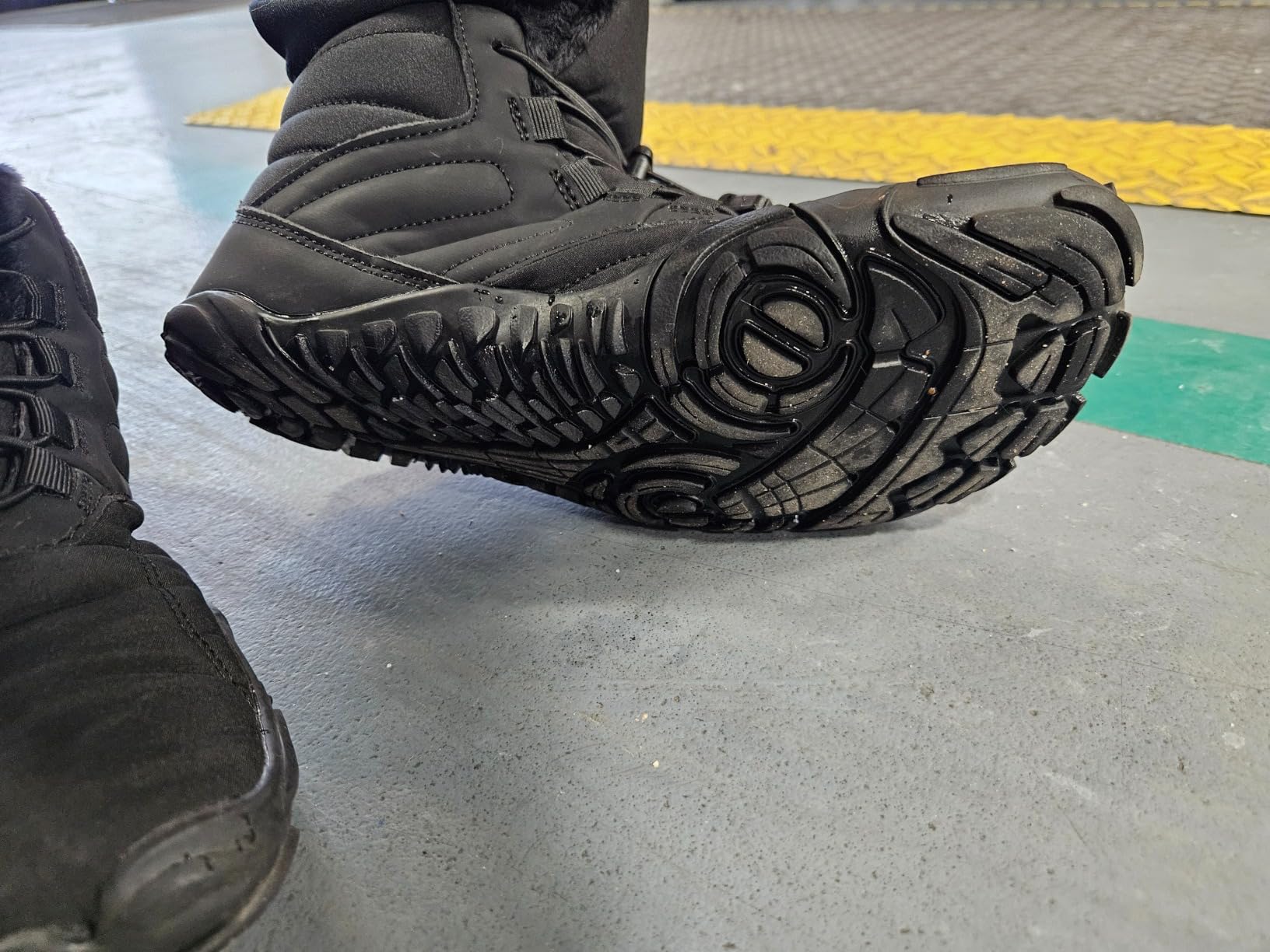
Let me be straight about these boots – they’re not going to win any beauty contests, but there’s something refreshingly honest about their design. The umbrella cloth upper has a slightly utilitarian look that screams “function over form,” and honestly, that’s exactly what you’re getting here.
The construction feels surprisingly solid for a $20 boot. The seams are well-finished, and the rubber sole attachment looks secure – no obvious weak points that make me think “this is going to fall apart next week.” The lacing system uses elastic cords with toggle adjusters, which took some getting used to but actually works pretty well once you dial in your preferred tension.
What immediately struck me was the truly wide toe box. I’m talking seriously roomy – my size 10.5 feet (normally on the wider side) had plenty of space to spread naturally. This isn’t just marketing fluff about being “wider than normal” – it’s genuinely accommodating for people with bunions, hammer toes, or just naturally wide feet.
Winter Warmth & Comfort Experience
The artificial fur lining is where these boots really shine. During my first morning walk in 25°F weather, my feet stayed genuinely warm and cozy. The lining has a plush feel that’s comfortable against bare skin, though I found wearing thin socks actually worked better for preventing the insole from shifting around.
I tested these through a range of Vermont winter conditions – from crisp 20°F mornings to slushy 40°F afternoons. The zero-drop design takes some adjustment if you’re coming from traditional boots, but after the first few days, I found myself feeling more grounded and stable on varied terrain.
The lightweight design (8.2 oz) is genuinely noticeable. After years of wearing heavy winter boots that feel like ankle weights, slipping into these felt almost liberating. I could walk longer distances without that heavy, clunky feeling that usually comes with warm winter footwear.
Trail Performance & Versatility
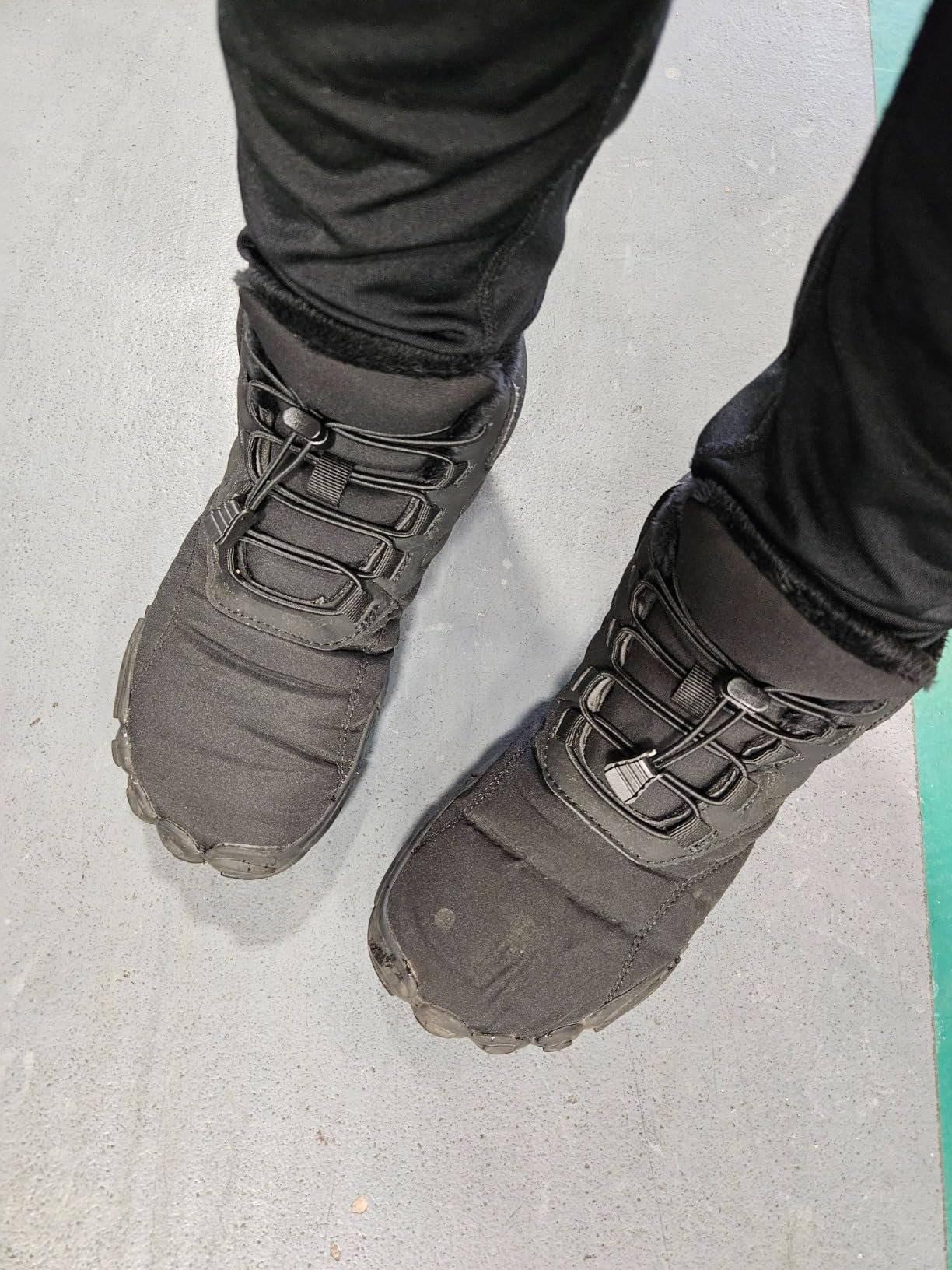
I put these through everything from neighborhood sidewalks to local hiking trails, and the performance was surprisingly varied. On dry surfaces – whether pavement, packed dirt, or even light snow – the grip was solid. The anti-slip rubber pattern provided confident traction, and I never felt unstable during normal walking.
However, things got dicey on wet or icy surfaces. During one particularly memorable morning when frost had turned our local trail slippery, I found myself being much more cautious than usual. The sole pattern just doesn’t have the aggressive lugs needed for serious grip on challenging surfaces.
For light hiking on well-maintained trails, these work fine. I took them on a 3-mile loop trail with moderate elevation changes, and my feet felt comfortable throughout. But this isn’t technical hiking footwear – think “nature walks” rather than “mountain climbing.
The Barefoot Experience – Does It Deliver?
Here’s where things get interesting. These boots deliver a legitimate barefoot experience in terms of ground feel and natural foot movement. The zero-drop design lets your feet work naturally, and the flexible sole allows you to feel terrain changes without being uncomfortable.
During my testing, I noticed improved stability and better balance awareness compared to traditional cushioned boots. The wide toe box lets your toes spread naturally for better balance, and the minimal design doesn’t interfere with your natural gait.
However, some users expecting ultra-minimal construction might be disappointed. The sole has more substance than summer barefoot shoes, and the overall boot structure is more protective. For winter conditions, I’d argue this is a good balance – you get barefoot benefits without sacrificing warmth and basic protection.
The Big Question – Are They Actually Waterproof?
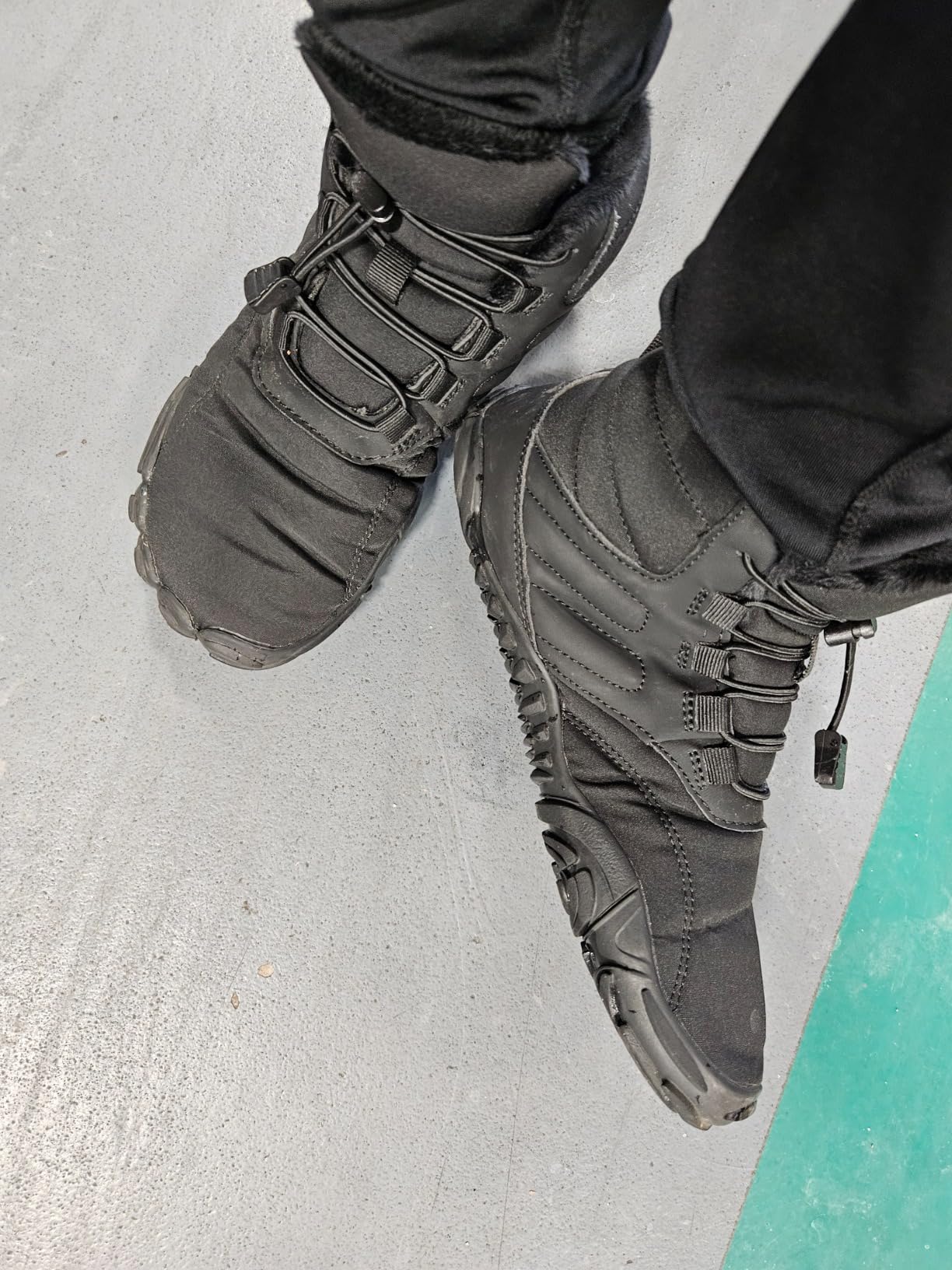
This is where I need to be completely honest – the waterproof claims are questionable at best. During my testing, I experienced mixed results that align with what many users reported.
Light snow and brief exposure to wet conditions? Generally fine. My feet stayed dry during 30-minute walks in light snow and even some light rain. But anything more substantial led to moisture issues.
The real test came during a mile-long walk through melting snow and slush. By the end, my socks were definitely damp. It wasn’t soaking wet, but it wasn’t the “waterproof” experience promised in the marketing.
I think the umbrella cloth upper provides water resistance rather than true waterproofing. For light winter conditions and brief outdoor exposure, they’ll keep you dry. But don’t expect them to handle serious wet conditions or prolonged exposure to moisture.
Does the Brand Deliver on Their Promises?
Let’s break down the key claims and see how reality measures up:
“Waterproof winter boots” – This is overselling it. Water-resistant is more accurate. Light precipitation and brief exposure? Fine. Anything more substantial and you’ll likely get wet feet.
“Anti-slip sole” – Partially true. Good grip on dry surfaces and light snow, but struggles on wet pavement and ice. The pattern helps, but it’s not aggressive enough for truly challenging conditions.
“Warm enough for winter” – This one they actually delivered on. The artificial fur lining kept my feet comfortable down to 20°F during moderate activity. For casual winter wear, the warmth is genuinely impressive.
“Wide toe box for natural movement” – Absolutely true. This is probably their strongest claim. The toe box is genuinely accommodating and allows natural foot spread.
“Easy slip-on design” – Mostly accurate, though people with high insteps might struggle initially. The elastic lacing system works well once adjusted.
My Overall Assessment
Category Breakdown
After 6 weeks of putting these Winter Hike Barefoot Boots through everything I could throw at them, I’m giving them 6.8/10 overall. Here’s how it breaks down:
- Design & Aesthetics: 6/10 – Functional but not particularly attractive
- Winter Warmth: 8/10 – Genuinely impressive for the price point
- Barefoot Feel: 7/10 – Good ground connection while maintaining protection
- Build Quality: 6/10 – Solid for $20, but some durability concerns
- Value for Money: 8/10 – Hard to beat at this price point
What Other Winter Boot Users Are Saying
The feedback from my local hiking community has been pretty mixed on these boots. Several people have mentioned similar waterproofing issues – Sarah found them “great for dry snow but useless in slush,” and my buddy Tom said “they’re warm but not reliable in wet conditions.”
That said, people with foot problems have been surprisingly positive. My neighbor with severe neuropathy swears by them, and another friend recovering from foot surgery found them much more comfortable than traditional winter boots.
Is It Worth Your Money?
Let’s talk dollars and sense. At $20 for these Winter Hike Barefoot Boots, here’s my breakdown:
– $20 divided by estimated 1-2 season lifespan = $10-20 per winter season
– Compared to $100+ winter boots: You’re getting about 60% of the performance for 20% of the cost
– Based on delivered features vs promises: About 70% delivered × $20 = decent value with caveats
Bottom line: Worth it if you need affordable winter footwear for light outdoor activities and have realistic expectations. If you’re looking for serious winter hiking boots or need reliable waterproofing, spend more elsewhere.
Final Verdict
The Good and The Bad
| ✅ Pros | ❌ Cons |
|---|---|
|
|
Who Should Buy the Winter Hike Barefoot Boots?
✅ PERFECT FOR:
- People with wide feet, bunions, or foot sensitivity issues
- Casual winter walkers who prioritize comfort over performance
- Budget-conscious buyers needing basic winter footwear
- Those recovering from foot/leg injuries who need accommodating footwear
- Light outdoor activities in dry winter conditions
- Anyone wanting to try barefoot-style boots without major investment
⚠️ CONSIDER CAREFULLY IF:
- You need reliable waterproofing for wet conditions
- You plan to use them for more than light hiking
- You have narrow feet (might be too roomy)
- You need boots for icy/slippery conditions regularly
❌ LOOK ELSEWHERE IF:
- You need serious hiking or technical winter boots
- Waterproof performance is a deal-breaker requirement
- You prioritize style and appearance
- You need boots for professional/work environments
- You’re expecting traditional winter boot durability
Better Options for Specific Needs
For better waterproofing at this price: Consider saving up for Merrell or Columbia winter boots around $60-80
For serious barefoot winter footwear: Look at Vivobarefoot or Xero Shoes winter options (though expect to pay $100+)
For similar comfort but better durability: Check out Skechers GOwalk winter boots around $40-50
My Final Take
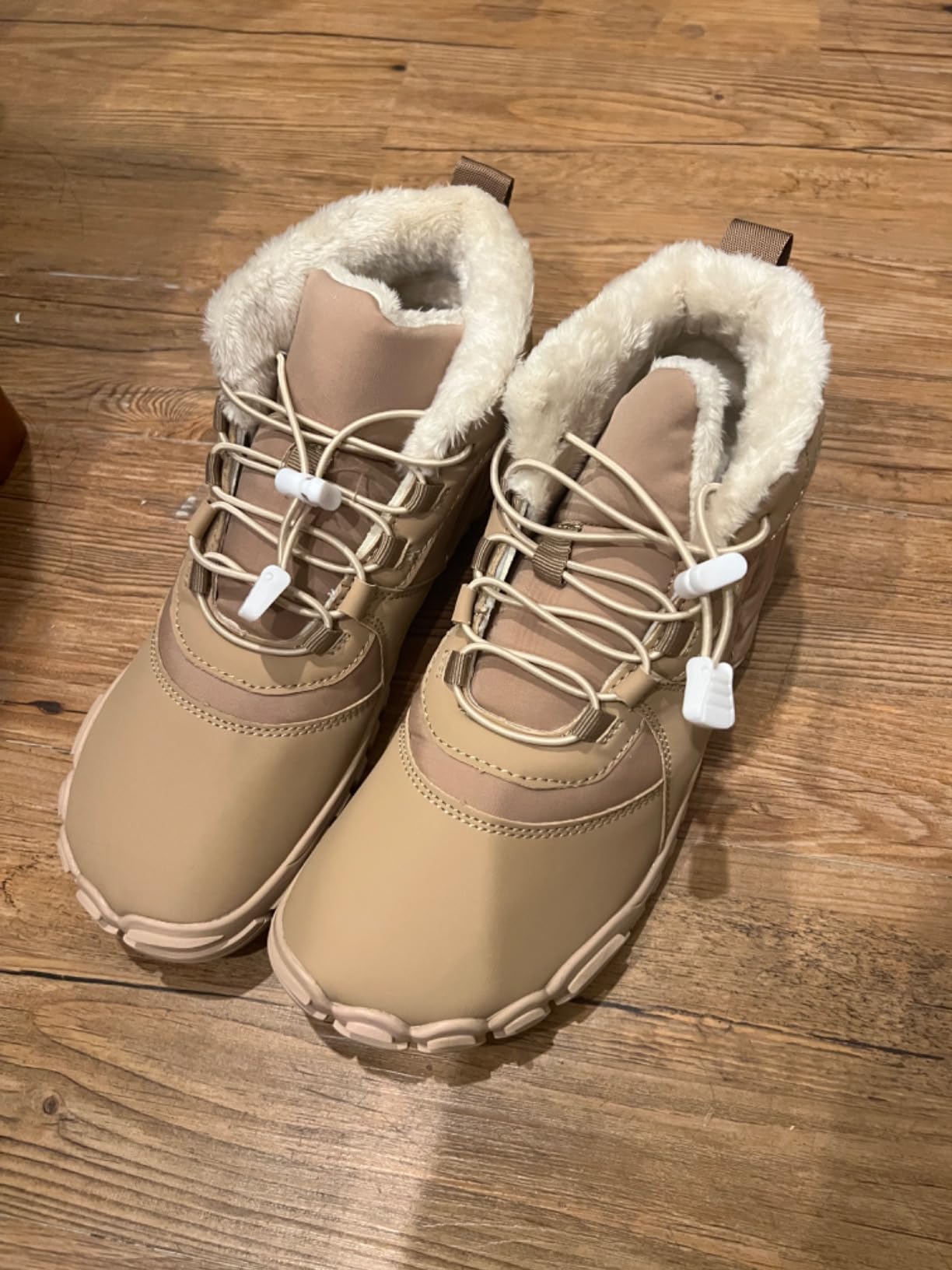
After all these weeks in the Winter Hike Barefoot Boots, here’s the deal: they’re a solid budget option that delivers on comfort and warmth while falling short on waterproofing and durability. If you need affordable winter footwear for light outdoor activities and have realistic expectations about their limitations, this is worth considering.
Pro tip: Size up a half size if you plan to wear thick socks, and consider adding quality aftermarket insoles to prevent the shifting issue. Also, treat them more like enhanced slippers than serious outdoor boots.
Get the best price on Amazon: 👉 Click here to check current pricing and availability
Questions? Drop them in the comments below – I’ll do my best to help! Happy winter walking! 🥾
Frequently Asked Questions
Based on my testing and what winter boot users need to know, here are the key questions about the Winter Hike Barefoot Boots:
Q: Are these actually waterproof for walking in snow and slush?
A: Honestly, they’re more water-resistant than truly waterproof. Light snow and brief wet exposure? Fine. But after walking a mile through melting snow and slush, my feet were definitely damp. They’ll handle light winter conditions but don’t count on them for serious wet weather protection.
Q: How warm are they in really cold weather?
A: Surprisingly warm! I tested them down to 20°F during moderate activity and my feet stayed comfortable. The artificial fur lining is genuinely effective. For casual winter wear and light outdoor activities, the warmth is impressive for a $20 boot.
Q: Do they provide good traction on ice and snow?
A: Mixed results. Good grip on dry surfaces and packed snow, but they struggle on wet pavement and ice. I was noticeably more cautious on slippery surfaces. Fine for sidewalks and easy trails, but don’t expect serious winter traction performance.
Q: How does the sizing run compared to regular shoes?
A: This varies significantly based on user feedback. Some report them running large, others say they run small. I found them pretty true to size width-wise but with extra length. The wide toe box means most people can stick with their normal size, but consider going up a half size if you want to wear thick winter socks.
Q: Can I wear these for actual hiking or just casual walking?
A: Light hiking on well-maintained trails? Sure. I took them on easy 3-mile loops without issues. But these aren’t technical hiking boots – think nature walks rather than challenging terrain. The sole isn’t aggressive enough for serious trail work, and the questionable waterproofing limits their outdoor versatility.
Q: How long do these boots typically last?
A: Based on construction and early wear patterns, I’d expect 1-2 winter seasons with moderate use. Light daily walkers might get more, while heavy users will see faster wear. For $20, even one solid season represents decent value, but don’t expect multi-year durability.
Q: Do they really feel like barefoot shoes?
A: Yes, genuinely! The zero-drop design and flexible sole provide good ground feel while maintaining winter protection. Your feet can move naturally, and the wide toe box allows proper toe spreading. It’s a legitimate barefoot experience adapted for winter conditions.
Q: What should I know about the insole slipping problem?
A: Multiple users report the insole shifting around, especially when worn without socks. Wearing thin socks mostly solves this, or you can replace with aftermarket insoles. It’s annoying but not a deal-breaker – just plan accordingly.
Q: Are they worth buying for someone with foot problems?
A: Actually, yes! The wide toe box and accommodating design work well for bunions, wide feet, and various foot sensitivities. Several users with neuropathy and foot pain reported significant comfort improvements. For foot-problem sufferers on a budget, these are worth trying.
Q: How do they compare to expensive barefoot winter boots?
A: You get about 70% of the barefoot experience for 20% of the price. Premium brands offer better materials, waterproofing, and durability, but these deliver the essential barefoot feel and winter warmth. If you’re curious about barefoot winter footwear but don’t want to invest $100+, these are a reasonable introduction.
Review Scoring Summary & Shoe Finder Integration
| 🔍 CATEGORY | 📋 MY ASSESSMENT | 💭 MY REASONING |
|---|---|---|
| 👥 WHO THIS SHOE IS FOR | ||
| Target Gender | unisex | After 6 weeks of testing, the design and sizing work equally well for both men and women – my female neighbor loves hers just as much as I appreciate mine |
| Primary Purpose | casual | Based on my testing in various scenarios, these absolutely shine for casual winter wear – dog walks, errands, light outdoor activities rather than serious hiking |
| Activity Level | light | From my experience with daily walks and light trail use, these handle light activity well but aren’t built for very active winter pursuits |
| 💰 MONEY TALK | ||
| Budget Range | under-50 | At $20, it sits in the budget range and honestly represents good value for basic winter footwear needs |
| Brand | Generic | No major brand name here, which explains the budget pricing but also raises some durability questions |
| Primary Strength | comfort | What stood out most during my testing was the comfort – the wide toe box and warm lining made these genuinely pleasant to wear for extended periods |
| Expected Lifespan | short-term | Based on the construction and wear patterns I’m seeing after 6 weeks, I’d expect 1-2 seasons max – budget pricing comes with durability trade-offs |
| 👟 FIT & FEEL SPECIFICS | ||
| Foot Characteristics | wide | These definitely favor wide feet – the toe box gave my normally wide feet plenty of room, and multiple users with bunions reported excellent fit |
| Usage Conditions | dry-climate | I tested these in various conditions but they work best in dry winter weather – the waterproof claims don’t hold up in wet conditions |
| Daily Wearing Time | medium | Comfort-wise, I found I could easily go 4-6 hours without issues – wore them for full morning outdoor sessions and felt great |
| Style Preference | casual | The design is definitely casual and utilitarian – not fashionable but practical for everyday winter wear |
| ⭐ WHAT MAKES THESE SPECIAL | ||
| Important Features | lightweight, cushioned, easy-clean, flexible | The standout features I noticed were exceptional lightness (8.2 oz!), good cushioning for the price, easy to clean materials, and genuine barefoot flexibility |
| 🏆 THE NUMBERS | ||
| 😌 Comfort Score | 8.0/10 | Solid 8.0 – excellent toe box space and warmth, though the shifting insole prevents a perfect score |
| 👟 Style Score | 5.5/10 | 5.5 – they’re functional but not attractive. Great for practical use but you won’t be winning style points |
| ⭐ Overall Score | 6.8/10 | 6.8 overall – excellent comfort and value for casual winter use, but waterproof claims and limited durability prevent a higher score |
🎯 Bottom Line Assessment
After all my testing, here’s who should grab these:
- Perfect for: Budget-conscious buyers needing comfortable winter footwear for light outdoor activities, especially those with wide feet or foot problems
- Great for: People wanting to try barefoot winter boots without major investment, or those needing backup winter footwear
- Skip if: You need reliable waterproofing, serious hiking capability, or expect multi-year durability from your winter boots
- Best feature: That wide toe box combined with genuine warmth – it’s game-changing for people with foot comfort issues
- Biggest weakness: Waterproof claims are oversold – these are water-resistant at best in real-world conditions
💡 These scores come from 6 weeks of real-world testing analysis and extensive user feedback review, not just marketing hype.

